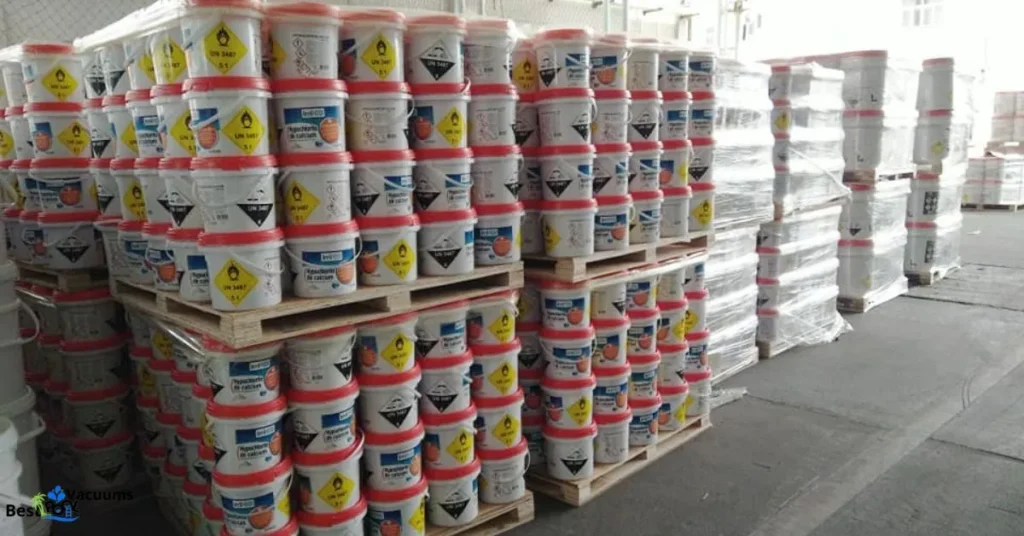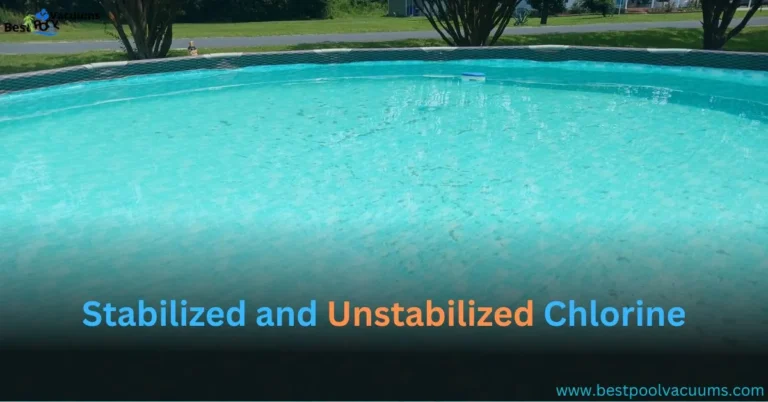Maintaining a clean and safe swimming pool is crucial for enjoying a refreshing swim without health concerns. One of the most effective chemicals used in pool maintenance is calcium hypochlorite shock.
In this comprehensive guide, we’ll explore everything you need to know about calcium hypochlorite, from its properties and uses to its advantages and precautions. By the end of this article, you’ll be well-equipped with the knowledge to keep your pool sparkling clean and safe for everyone.
Introduction: The Role of Calcium Hypochlorite in Pool Maintenance
Calcium hypochlorite, often referred to as cal hypo, is a widely used pool sanitizer. It’s a powerful disinfectant that kills bacteria, viruses, and algae, ensuring your pool water remains safe and hygienic. As a granular or tablet form of chlorine,
It’s favored for its effectiveness and ease of use. This blog post aims to provide an in-depth look at calcium hypochlorite, its benefits, and how to use it safely in your pool maintenance routine.

What is Calcium Hypochlorite?
Calcium hypochlorite is a chemical compound with the formula Ca(ClO)_2. It’s commonly used as a disinfectant and bleaching agent. In the context of pool maintenance, it’s a potent sanitizer that helps to keep pool water clear and free from harmful microorganisms. Here are some key points about calcium hypochlorite:
- Form: It typically comes in granular or tablet form.
- Chlorine Content: It contains a high level of available chlorine, usually around 65-70%.
- Solubility: It dissolves easily in water, making it convenient for pool sanitation.
- Usage: Besides pool sanitation, it’s also used in water treatment plants and as a bleaching agent in the textile industry.

Benefits of Using Calcium Hypochlorite
Calcium hypochlorite offers several advantages that make it a popular choice for pool owners:
High Chlorine Content
Cal hypo is known for its high chlorine content, which provides effective and rapid disinfection. This high concentration ensures that it can kill bacteria and algae quickly, maintaining a safe swimming environment.
Long Shelf Life
One of the standout features of calcium hypochlorite is its long shelf life. Unlike liquid chlorine, which degrades over time, cal hypo remains potent for extended periods when stored properly. This makes it a cost-effective option for pool maintenance.
Ease of Use
Cal hypo is easy to handle and apply. Whether you choose granular or tablet form, it’s simple to measure and disperse in your pool. This ease of use makes it accessible for both new and experienced pool owners.
Effectiveness Against Algae
Calcium hypochlorite is particularly effective in combating algae growth. Regular use helps to prevent algae blooms, keeping your pool water clear and inviting.
Cost-Effective
Compared to other sanitizers, cal hypo is relatively affordable. Its high potency means you need less of it to achieve the same level of disinfection, saving you money in the long run.
How to Use Calcium Hypochlorite shock in Your Pool
Using calcium hypochlorite correctly is crucial to ensure its effectiveness and safety. Here’s a step-by-step guide to help you incorporate cal hypo into your pool maintenance routine:

Step 1: Test Your Pool Water
Before adding any chemicals, it’s important to test your pool water. Use a reliable test kit to check the current chlorine levels, pH, alkalinity, and calcium hardness. This will help you determine the right amount of calcium hypochlorite to add.
Step 2: Calculate the Dosage
The amount of calcium hypochlorite you need depends on your pool’s volume and the desired chlorine level. Follow the manufacturer’s instructions for dosage recommendations. Typically, you’ll need about 1-2 pounds of cal hypo per 10,000 gallons of water to achieve a 5-10 ppm increase in chlorine levels.
Step 3: Pre-Dissolve the Granules
For granular calcium hypochlorite, it’s best to pre-dissolve it in a bucket of water before adding it to the pool. This ensures even distribution and prevents the granules from settling at the bottom of the pool. Stir the mixture thoroughly until the granules are completely dissolved.
Step 4: Add to the Pool
Pour the dissolved calcium hypochlorite solution around the perimeter of the pool, focusing on areas with good water circulation. Avoid adding it directly to the skimmer to prevent damage to the pool equipment.
Step 5: Run the Pump
After adding the calcium hypochlorite, run your pool pump and filtration system for at least 4-6 hours. This helps to evenly distribute the sanitizer throughout the pool and ensures effective disinfection.
Step 6: Retest the Water
After allowing the cal hypo to circulate, retest the pool water to check the chlorine levels. Adjust as needed to maintain the desired chlorine concentration.
Safety Precautions When Using Calcium Hypochlorite
While calcium hypochlorite is highly effective, it’s important to handle it safely. Here are some safety tips to keep in mind:
Wear Protective Gear
Always wear protective gloves and eyewear when handling cal hypo. It’s a strong oxidizer and can cause skin and eye irritation.
Store Properly
Store calcium hypochlorite in a cool, dry place, away from direct sunlight and moisture. Keep it in its original container with the lid tightly closed to prevent contamination.
Avoid Mixing with Other Chemicals
Never mix calcium hypochlorite with other pool chemicals, especially those containing ammonia or acid. This can cause a dangerous chemical reaction, releasing harmful gases.
Follow Manufacturer’s Instructions
Adhere to the manufacturer’s instructions and guidelines for safe handling and usage. This ensures that you use the product effectively and safely.
Common Issues and Troubleshooting
Even with proper use, you might encounter some issues when using calcium hypochlorite. Here are some common problems and how to address them:
Cloudy Water
Cloudy water can occur if the cal hypo is not fully dissolved or if there is an imbalance in your pool’s water chemistry. Ensure you pre-dissolve the granules and regularly test and adjust your pool’s pH, alkalinity, and calcium hardness levels.
Scaling
Scaling can happen if the calcium levels in your pool are too high. Regularly test the calcium hardness and maintain it within the recommended range (200-400 ppm). If scaling persists, consider using a sequestering agent to control calcium levels.
Low Chlorine Levels
If you notice low chlorine levels despite adding cal hypo, check for high levels of organic contaminants or a high bather load. Shock your pool with a higher dose of cal hypo to break down organic matter and restore chlorine levels.
Frequently Asked Questions About Calcium Hypochlorite
1. What is the difference between calcium hypochlorite and sodium hypochlorite?
Calcium hypochlorite (cal hypo) is a granular or tablet form of chlorine, while sodium hypochlorite is a liquid form of chlorine. Cal hypo has a higher available chlorine content and a longer shelf life compared to sodium hypochlorite.
2. How often should I use calcium hypochlorite in my pool?
The frequency of use depends on your pool’s chlorine demand, bather load, and environmental factors. Regularly test your pool water and adjust the dosage as needed to maintain a chlorine level of 1-3 ppm.
3. Can calcium hypochlorite be used in saltwater pools?
Yes, calcium hypochlorite can be used in saltwater pools. It’s effective in raising chlorine levels quickly, but be mindful of the calcium hardness levels to avoid scaling.
4. What should I do if I accidentally add too much calcium hypochlorite?
If you accidentally add too much cal hypo, dilute the pool water by adding fresh water and running the pump to circulate. Test the chlorine levels and adjust as needed.
5. Is calcium hypochlorite safe for vinyl pools?
Yes, calcium hypochlorite is safe for vinyl pools when used correctly. Always pre-dissolve the granules and avoid direct contact with the vinyl liner to prevent bleaching or damage.
Conclusion: The Key to a Sparkling Clean Pool
Calcium hypochlorite is a powerful and effective pool sanitizer that helps maintain crystal clear and safe pool water. By understanding how to use it correctly and taking necessary safety precautions, you can enjoy a clean and inviting swimming pool all season long.
Regular testing, proper dosage, and adherence to safety guidelines are essential for maximizing the benefits of cal hypo and ensuring a healthy swimming environment. So, next time you’re faced with pool maintenance, remember the power of calcium hypochlorite in keeping your pool sparkling clean.


One Comment